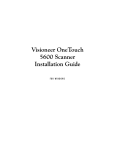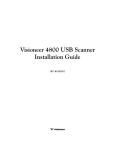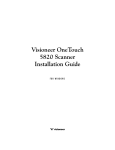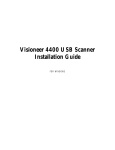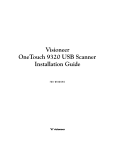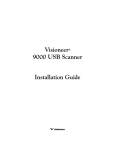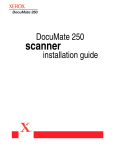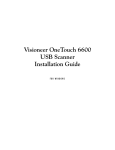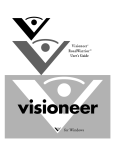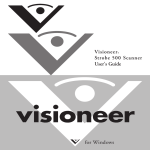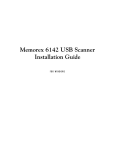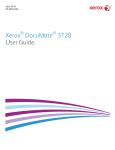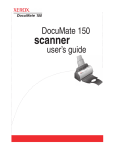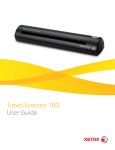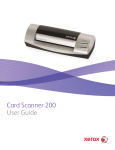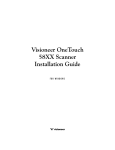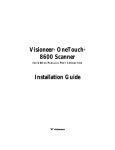Download Visioneer 6200 Scanner User Manual
Transcript
Visioneer® 6200/6400 Scanner FOR USB OR PARALLEL PORT CONNECTION Installation Guide COPYRIGHT INFORMATION Copyright © 1999 Visioneer, Inc., a wholly owned subsidiary of Primax Electronics LTD. Reproduction, adaptation, or translation without prior written permission is prohibited, except as allowed under the copyright laws. The Visioneer brand name and logo are registered trademarks of Primax Electronics LTD. OneTouch is a trademark of Primax Electronics LTD. The PaperPort brand name and logo are registered trademarks of ScanSoft, Inc. Microsoft is a U.S. registered trademark of Microsoft Corporation. Windows is a trademark of Microsoft Corporation. TextBridge is a registered trademark of ScanSoft, Inc. ZyINDEX is a registered trademark of ZyLAB International, Inc. ZyINDEX toolkit portions, Copyright © 1990-1998, ZyLAB International, Inc. All Rights Reserved. All other products mentioned herein may be trademarks of their respective companies. Information is subject to change without notice and does not represent a commitment on the part of Visioneer. The software described is furnished under a licensing agreement. The software may be used or copied only in accordance with the terms of such an agreement. It is against the law to copy the software on any medium except as specifically allowed in the licensing agreement. No part of this document may be reproduced or transmitted in any form or by any means, electronic or mechanical, including photocopying, recording, or information storage and retrieval systems, or translated to another language, for any purpose other than the licensee's personal use and as specifically allowed in the licensing agreement, without the express written permission of Visioneer. Part Number: 05-0401-000 Restricted Rights Legend Use, duplication, or disclosure is subject to restrictions as set forth in contract subdivision (c)(1)(ii) of the Rights in Technical Data and Computer Software Clause 52.227-FAR14. Material scanned by this product may be protected by governmental laws and other regulations, such as copyright laws. The customer is solely responsible for complying with all such laws and regulations. Visioneer's Limited Product Warranty If you find physical defects in the materials or the workmanship used in making the product described in this document, Visioneer will repair, or at its option, replace, the product at no charge to you, provided you return it (postage prepaid, with proof of your purchase from the original reseller) during the 12-month period after the date of your original purchase of the product. THIS IS VISIONEER'S ONLY WARRANTY AND YOUR EXCLUSIVE REMEDY CONCERNING THE PRODUCT, ALL OTHER REPRESENTATIONS, WARRANTIES OR CONDITIONS, EXPRESS OR IMPLIED, WRITTEN OR ORAL, INCLUDING ANY WARRANTY OF MERCHANTABILITY, FITNESS FOR A PARTICULAR PURPOSE OR NON-INFRINGEMENT, ARE EXPRESSLY EXCLUDED. AS A RESULT, EXCEPT AS SET OUT ABOVE, THE PRODUCT IS SOLD “AS IS” AND YOU ARE ASSUMING THE ENTIRE RISK AS TO THE PRODUCT'S SUITABILITY TO YOUR NEEDS, ITS QUALITY AND ITS PERFORMANCE. IN NO EVENT WILL VISIONEER BE LIABLE FOR DIRECT, INDIRECT, SPECIAL, INCIDENTAL OR CONSEQUENTIAL DAMAGES RESULTING FROM ANY DEFECT IN THE PRODUCT OR FROM ITS USE, EVEN IF ADVISED OF THE POSSIBILITY OF SUCH DAMAGES. All exclusions and limitations in this warranty are made only to the extent permitted by applicable law and shall be of no effect to the extent in conflict with the express requirements of applicable law. FCC Radio Frequency Interference Statement This equipment has been tested and found to comply with the limits for the class B digital device, pursuant to part 15 of the FCC Rules. These limits are designed to provide reasonable protection against interference in a residential installation. This equipment generates, uses and can radiate radio frequency energy and if not installed, and used in accordance with the instructions, may cause harmful interference to radio communications. However, there is no guarantee that interference will not occur in a particular installation. If this equipment does cause harmful interference to radio or television reception, which can be determined by turning the equipment off and on, the user is encouraged to try and correct the interference by one or more of the following measures: • Reorient or relocate the receiving antenna. • Increase the separation between the equipment and receiver. • Connect the equipment into an outlet on a circuit different from that to which the receiver is connected. • Consult the dealer or an experienced radio/TV technician for help. This equipment has been certified to comply with the limits for a class B computing device, pursuant to FCC Rules. In order to maintain compliance with FCC regulations, shielded cables must be used with this equipment. Operation with non-approved equipment or unshielded cables is likely to result in interference to radio and TV reception. The user is cautioned that changes and modifications made to the equipment without the approval of manufacturer could void the user's authority to operate this equipment. This device complies with part 15 of the FCC Rules. Operation is subject to the following two conditions: (1) This device may not cause harmful interference, and (2) this device must accept any interference received, including interference that may cause undesired operation TABLE OF CONTENTS i TA B L E O F C O N T E N T S Welcome . . . . . . . . . . . . . . . . . . . . . . . . . . . . . . . . . . . . . . . . . . . . . . 1 What’s in the Box . . . . . . . . . . . . . . . . . . . . . . . . . . . . . . . . . . . . . . . 1 The Visioneer 6200/6400 Scanner . . . . . . . . . . . . . . . . . . . . . . . . . . . 2 What You Need . . . . . . . . . . . . . . . . . . . . . . . . . . . . . . . . . . . . . . . . . 4 Getting the PaperPort Software User’s Guide . . . . . . . . . . . . . . . . . . 4 Part 1: Installing Your Scanner Installing to a USB Port . . . . . . . . . . . . . . . . . . . . . . . . . . . . . . . . . . . 5 STEP 1: Installing the PaperPort Software . . . . . . . . . . . . . . . . . 5 STEP 2: Connecting to a USB Port . . . . . . . . . . . . . . . . . . . . . . . 7 Installing to a Parallel Port . . . . . . . . . . . . . . . . . . . . . . . . . . . . . . . . 11 STEP 1: Connecting to a Parallel Port . . . . . . . . . . . . . . . . . . . . 11 STEP 2: Installing the PaperPort Software . . . . . . . . . . . . . . . . 14 Checking Your Scanner . . . . . . . . . . . . . . . . . . . . . . . . . . . . . . . . . . 15 Checking a Scanner Connected to a Parallel Port . . . . . . . . . . . 16 Checking a Scanner Connected to a USB Port . . . . . . . . . . . . . 17 If the Scanner Is Not Properly Connected . . . . . . . . . . . . . . . . . 19 Scanning for the First Time . . . . . . . . . . . . . . . . . . . . . . . . . . . . . . . 20 Part 2: Configuring the OneTouch Software and Scanning Items Scanning from the OneTouch Software . . . . . . . . . . . . . . . . . . . . . . 23 Configuring the OneTouch Software . . . . . . . . . . . . . . . . . . . . 24 About the OneTouch Configuration Dialog Box . . . . . . . . . . . 26 Getting Help in the OneTouch Software . . . . . . . . . . . . . . . . . 28 Selecting a Different Configuration . . . . . . . . . . . . . . . . . . . . . . 29 Creating New Configurations . . . . . . . . . . . . . . . . . . . . . . . . . . 30 Adjusting Scan Settings and Page Settings . . . . . . . . . . . . . . . . . 30 About JPEG Compression . . . . . . . . . . . . . . . . . . . . . . . . . . . . . 34 ii TABLE OF CONTENTS Setting Preferences . . . . . . . . . . . . . . . . . . . . . . . . . . . . . . . . . . . 36 Changing the Linked Application . . . . . . . . . . . . . . . . . . . . . . . . . . 38 Scanning from the PaperPort Software . . . . . . . . . . . . . . . . . . . . . . 39 Scanning an Item with the Twain Button . . . . . . . . . . . . . . . . . 40 Adjusting the Brightness and Contrast . . . . . . . . . . . . . . . . . . . 44 Getting Help with the PaperPort Software . . . . . . . . . . . . . . . . 45 About the Predefined Scan Settings in PaperPort . . . . . . . . . . . . 46 Cleaning the Scanner Glass . . . . . . . . . . . . . . . . . . . . . . . . . . . . . . . 47 Visioneer Scanner Specifications . . . . . . . . . . . . . . . . . . . . . . . . . . . 48 WELCOME Congratulations on purchasing your Visioneer flatbed scanner. With your scanner, you can quickly scan paper documents and color photos to place their electronic images on your computer. This guide tells you how to connect your scanner, scan items, and configure the OneTouch software. You can connect the Visioneer 6400 scanner to either your computer’s USB or parallel port; however, the Visioneer 6200 scanner must be connected to a USB port. This guide contains instructions for connecting to either port: ■ For USB port instructions, see page 5. ■ For parallel port instructions, see page 11. WHAT’S IN THE BOX Before starting the installation, check the contents of the box to make sure that all parts are included. If any items are missing or damaged, contact the dealer where you purchased the scanner. USB cable Parallel cable— 6400 only Visioneer 6200/6400 Scanner Software CD Installation guide Power supply VISIONEER 6200/6400 SCANNER INSTALLATION GUIDE 1 2 VISIONEER 6200/6400 SCANNER INSTALLATION GUIDE THE VISIONEER 6200/6400 SCANNER Document cover Document pad Glass Reference frame OneTouch button Rear of 6400 Scanner Power jack ADF/TPA port Host Parallel port USB port (behind sliding latch) Printer Parallel port Rear of 6200 Scanner Power jack ADF/TPA port USB port THE VISIONEER 6200/6400 SCANNER 3 Document cover. Close the document cover after placing items on the scanner glass. Document pad. Helps to secure the document in place on the scanner glass. Glass. Place items face down on top of the glass in the upper left corner. Reference frame. Place items face down within this frame. Markings on the border of the frame show where to align various paper sizes. OneTouch button panel. Press the OneTouch button to scan with custom settings. Power jack. Plug the scanner power cord into this jack. ADF/TPA port. A port for an optional Auto Document Feeder (ADF) and a Transparency Adapter (TPA) for scanning transparencies. Please visit our web site at www.visioneer.com for more information about acquiring these optional devices. Host Parallel port (6400 scanner only). If you’re connecting the scanner to the computer’s parallel port, plug one end of the parallel cable into this port. Do not use this port when connecting with the USB cable. Plug the other end of the parallel cable into the computer’s parallel port. USB port. On the 6400 scanner, a sliding latch covers and protects the USB port. Slide the latch to the side to see the USB port. On the 6200 scanner, the USB port is clearly visible. Plug one end of the USB cable into this port; plug the other end into a USB port on the computer or keyboard. Do not use this port when connecting with a parallel cable. Printer Parallel port. Use this port only if you connect a printer directly to your computer. Unplug the printer from the computer and plug it into this parallel port on the scanner. 4 VISIONEER 6200/6400 SCANNER INSTALLATION GUIDE WHAT YOU NEED To use the Visioneer scanner and software, you need the following: ■ IBM PC (or 100-percent compatible) Pentium or equivalent ■ Microsoft Windows 95, Windows 98, or Microsoft NT 4.0 ■ One available Universal Serial Bus (USB) port or one available parallel port on your computer; Microsoft Windows 98 is required when using the USB port ■ 32 megabytes (MB) or more of available internal memory (RAM) ■ 70 MB of free hard disk space ■ A VGA or SVGA monitor. Recommended settings for your monitor are as many colors as possible—High Color (16-bit), True Color (24-bit or 32-bit). Set the resolution to at least 800 by 600 pixels. To set your monitor’s colors and resolution, open the Windows Control Panel, double-click Display, and then click the Settings tab. ■ A CD-ROM drive GETTING THE PAPERPORT SOFTWARE USER’S GUIDE The CD also includes your PaperPort User’s Guide. This guide provides more detailed information about the PaperPort software’s features. Please see the CD to view or print the guide. INSTALLING TO A USB PORT 5 Part 1: Installing Your Scanner INSTALLING TO A USB PORT This section of the guide contains instructions for connecting your Visioneer scanner to a USB port. If you are connecting the 6400 scanner to a parallel port, see “Installing to a Parallel Port” on page 11 for more information. STEP 1: INSTALLING THE PAPERPORT SOFTWARE Note: You must install the PaperPort software before connecting the scanner to the computer. Otherwise the correct software to run your scanner will not be installed and it may not scan properly. The PaperPort CD includes all the necessary installation files, as well as PaperPort software files and other software files. The CD also includes the PaperPort User’s Guide. You can read the guide from the CD, or print a copy directly from the CD. To install the PaperPort software: 1. Start Microsoft Windows 98 and make sure that no other applications are running. Microsoft Windows 98 is required to connect the scanner to a USB port. 2. Insert the PaperPort CD into your computer’s CD-ROM drive. The CD automatically starts. 6 VISIONEER 6200/6400 SCANNER INSTALLATION GUIDE Note: If the PaperPort CD does not automatically start, make sure the CD drive’s door is completely shut. If the CD still doesn’t start, the Autorun option on your computer is turned off. Click the Windows icon named My Computer. The window shows the drives available on your computer. Double-click the icon for your CD-ROM drive to see the list of files on the CD. Double-click the file named START32.EXE. The CD starts. 3. Follow the instructions on the screen to install the PaperPort software on your computer. During installation, a message tells you to connect the scanner to the computer. 4. Follow the steps in the next section to connect the scanner. When you’re finished, click Finish in the dialog box above. INSTALLING TO A USB PORT 7 STEP 2: CONNECTING TO A USB PORT The Visioneer scanner connects to any available USB port. Check your computer’s user’s guide for its USB port locations. Note: You do not have to shut off the power to your computer when connecting the scanner to a USB port. To connect the Visioneer scanner to a USB port: 1. Plug one end of the USB cable into an available USB port. Some newer computers also have keyboards with USB ports. You can plug the scanner into the keyboard instead of the USB port on the computer. 2. If you are connecting the 6400 scanner, slide the latch on the back of the scanner to uncover its USB port. USB port If you are connecting a 6200 scanner, the USB port is shown in the following figure. USB port 8 VISIONEER 6200/6400 SCANNER INSTALLATION GUIDE 3. Plug the other end of the USB cable into the scanner’s USB port. 6400 scanner 6200 scanner If the plug does not attach easily, make sure that you are plugging it in correctly. Do not force the plug into the connection. 4. Plug the power adapter cable into the power jack on the back of the scanner. INSTALLING TO A USB PORT 5. Turn the scanner over to see the locking tab on the bottom. Slide the locking tab to the unlocked position. Unlocked position 6. Plug the power adapter into an AC (wall) outlet. The following diagram shows the 6400 scanner connected to a computer. Power cord USB cable 9 10 VISIONEER 6200/6400 SCANNER INSTALLATION GUIDE The following diagram shows the 6200 scanner connected to a computer. Power cord USB cable Your computer recognizes that a scanner has been plugged into the USB port and automatically loads the appropriate software from the CD to run the scanner. When the software has finished loading, the Finish button on the dialog box becomes active. 7. Click the Finish button. That completes the steps to connect your scanner to the computer. 8. Remove the CD from the computer and store it in a safe place. 9. Turn to “Checking Your Scanner” on page 15 to continue setting up your Visioneer scanner. Note: The locking tab protects the scanner’s scan head by holding it securely in position. Lock the scanner when transporting it from one location to another, but always remember to unlock it before scanning. The scanner will not scan when locked. INSTALLING TO A PARALLEL PORT 11 INSTALLING TO A PARALLEL PORT This section explains how to connect the Visioneer scanner to a parallel port. If you are connecting a 6200 scanner, you must connect it to a USB port. For more information, see “Installing to a USB Port” on page 5. STEP 1: CONNECTING TO A PARALLEL PORT The Visioneer 6400 scanner connects to any available parallel (LPT) port on the back of your computer. To connect the 6400 scanner to a parallel port: 1. Save any open files, and then shut down Windows. 2. Turn off the power to your computer. 3. If a printer is already attached to your computer’s parallel port, unplug the printer cable from the computer. If you don’t have a printer attached to your computer, skip this step. 12 VISIONEER 6200/6400 SCANNER INSTALLATION GUIDE 4. Plug one end of the scanner cable into the port on the back of the scanner marked “Host.” 5. Plug the other end of the scanner cable into the parallel port on the back of your computer. On some older computers the serial port and parallel port both have 25-pin connectors that fit the scanner cable. Make sure you plug the scanner cable into a parallel port. INSTALLING TO A PARALLEL PORT 13 6. If you unplugged a printer from the parallel port earlier, plug it into the “Printer” port on the scanner. 7. Plug the power adapter cable into the jack on the scanner. 8. Turn the scanner over to see the locking tab on the bottom. Slide the locking tab to the unlocked position. Unlocked position 14 VISIONEER 6200/6400 SCANNER INSTALLATION GUIDE 9. Plug the power adapter into an AC (wall) outlet. The following diagram shows the 6400 scanner connected to a computer. Power cord Parallel cable to the computer Parallel cable to the printer 10. Turn on your computer. You’re now ready to install the software. Note: The locking tab protects the scanner’s scan head by holding it securely in position. Lock the scanner when transporting it from one location to another, but always remember to unlock it before scanning. The scanner will not scan when locked. STEP 2: INSTALLING THE PAPERPORT SOFTWARE The PaperPort CD contains the PaperPort software files, all the necessary installation files, and files for other applications as well. The CD also includes the PaperPort User’s Guide. You can read the guide from the CD, or print a copy from the CD. CHECKING YOUR SCANNER 15 To install the PaperPort software: 1. Start Microsoft Windows and make sure that no other applications are running. 2. Insert the PaperPort CD into your computer’s CD-ROM drive. The CD automatically starts. Note: If the PaperPort CD does not automatically start, make sure the CD drive’s door is completely shut. If the CD still doesn’t start, the Autorun option on your computer is turned off. Click the Windows icon named My Computer. The window shows the drives available on your computer. Double-click the icon for your CD-ROM drive to see the list of files on the CD. Double-click the file named START32.EXE. The CD starts. 3. Click the PaperPort Software button and follow the instructions on the screen. After the PaperPort software is installed on your computer, you can click the appropriate buttons on the CD to install the other applications on the CD or print the PaperPort User’s Guide. 4. When you’re finished installing the software, remove the CD from the CD drive and store the CD in a safe place. 5. Restart the computer. That completes the installation. Please see “Checking Your Scanner” on page 15 to continue setting up your Visioneer scanner. CHECKING YOUR SCANNER Depending on whether your scanner is connected to a parallel port or USB port, you use different ways to check if the scanner is properly connected. If the scanner is connected to: ■ A parallel port, see “Checking a Scanner Connected to a Parallel Port” on this page. ■ A USB port, see “Checking a Scanner Connected to a USB Port” on page 17. 16 VISIONEER 6200/6400 SCANNER INSTALLATION GUIDE CHECKING A SCANNER CONNECTED TO A PARALLEL PORT When you connect the 6400 scanner to a parallel port, the scanner icon appears in the Windows taskbar (at the bottom right corner of the computer screen). If the scanner is properly connected, the scanner icon looks like the one in this figure. Scanner Icon If the icon has a red X through it, the scanner is not properly connected. See the section, “If the Scanner Is Not Properly Connected” on page 19 for the steps to fix the problem. To check the status of the scanner: 1. Place the mouse pointer on the scanner icon in the Windows taskbar. 2. Right-click the icon. The shortcut menu appears. CHECKING YOUR SCANNER 17 3. Choose About from the shortcut menu. A dialog box confirms that the scanner is properly connected. The About dialog box shown below is for a 6400 scanner connected to a parallel port. 4. Click OK to close the dialog box. That’s it. Your scanner is ready to scan. See “Scanning for the First Time” on page 20. Note: The scanning lamp under the scanner’s glass needs to warm up before you can scan. A status message lets you know when the lamp is ready. The lamp then remains ready so you don’t have to wait for it to warm up each time you want to scan. To conserve electricity and prolong the life of the scanner, you can set the length of time for the lamp to remain lit before powering down. See “Setting Preferences” on page 36. CHECKING A SCANNER CONNECTED TO A USB PORT After you have installed the scanner to a USB port, you can check if it is properly connected using the Scanners and Cameras setting in the Windows Control Panel. To check the status of the scanner: 1. From the Start menu, choose Control Panel, and then Settings. The Control Panel window opens. 18 VISIONEER 6200/6400 SCANNER INSTALLATION GUIDE 2. Double-click the Scanners and Cameras icon. The Scanners and Cameras Properties dialog box appears. The following example shows the Visioneer 6400 scanner connected to your computer. If you have a video camera or other scanner connected, those devices may appear in this dialog box. 3. Select the Visioneer scanner and click Properties. The Properties dialog box appears. CHECKING YOUR SCANNER 19 4. Click the Test Scanner or Camera button. A message tells you if the scanner is working correctly. 5. Click OK to close the dialog box. That’s it. Your scanner is ready to scan. See “Scanning for the First Time” on page 20. If the scanner is not properly connected, you’ll need to find the problem. See the next section for help. IF THE SCANNER IS NOT PROPERLY CONNECTED If the scanner is not properly connected, check for one of these possible problems: • Is a cable loose or not plugged in securely? Inspect all cable connections. Make sure all the cables are plugged in securely. • Is the scanner’s locking tab in the locked position? Slide the locking tab to the unlocked position. If you tried to scan with the scanner locked, you must restart your computer after unlocking the scanner. • If you connected the scanner to a parallel port, are you using an older computer that has 25-pin connectors for both serial and parallel ports? You may have plugged the scanner cable into a serial port instead of the parallel port. Remove the scanner cable from the serial port and plug the cable into the parallel port. • If you connected the scanner to a parallel port, are other devices “daisy-chained” to the parallel port? If so, the scanner must be the first one connected to the computer. Plug the scanner into the computer’s parallel port first, then plug the next device into the scanner. • Did you restart the computer after installing the software? If you didn’t restart the computer, it may not have loaded all of the software files. Try restarting your computer. 20 VISIONEER 6200/6400 SCANNER INSTALLATION GUIDE Please see the Readme file in the PaperPort directory on your computer’s hard drive. The Readme file contains additional information that may help you diagnose problems connecting the scanner. To reconnect the scanner if it is connected to a parallel port: 1. Right-click the scanner icon with the red X over it. The shortcut menu appears. 2. Choose Connect from the shortcut menu. The software finds the scanner and makes the connection. The scanner icon will no longer have a red X through it, and you’re ready to begin scanning. If your scanner is connected to a USB port: ■ See “Checking a Scanner Connected to a USB Port” on page 17 to test the scanner using Scanners and Cameras setting in the Control Panel. If you try all the troubleshooting procedures described above and in the Readme file and the scanner is not working, see the technical support card that came with your scanner for technical assistance telephone numbers. Also visit our web site at www.visioneer.com for additional technical information. SCANNING FOR THE FIRST TIME To scan an item, you simply press the button on the scanner. The OneTouch software automatically scans an item, uses the color setting, and selects the PaperPort software as the default destination application. SCANNING FOR THE FIRST TIME 21 The destination application is the application in which the scanned item appears after the scan has finished. You can change the destination application and will learn how later in this guide. To test your scanner: 1. Before starting, find an item to scan, such as a letter, magazine article, or report. 2. Place the item to scan on the glass, face down, and press the button on the scanner. During scanning, the scan progress window shows a small copy of the image, as illustrated by this example: When the scan is complete, the scanned image appears in the PaperPort software. 22 VISIONEER 6200/6400 SCANNER INSTALLATION GUIDE Thumbnail image For more information about using PaperPort or scanning with PaperPort, see “Scanning from the PaperPort Software” on page 39. SCANNING FROM THE ONETOUCH SOFTWARE 23 Part 2: Configuring the OneTouch Software and Scanning Items When you scan with your Visioneer scanner, there are different ways to scan items. You can scan items by: ■ Pressing the button on the scanner and using the OneTouch software. ■ Using the PaperPort software (or other Twain software). The advantage of the OneTouch software is that you can scan items directly to preconfigured applications. For example, if you want to scan an item and edit it in Adobe Photoshop, you can configure the OneTouch software to display the scanned item in Photoshop immediately after the item is scanned. SCANNING FROM THE ONETOUCH SOFTWARE You press the scanner button to scan an item, and then send the image either to the printer, or to a software application on your computer. To scan by pressing the button on the scanner: • Place an item to scan on the glass, face down, and press one of the scanner button. The scanner starts scanning the item. Parallel only—If your computer is connected to a parallel port, a message above the Windows taskbar shows the status of the scanning. 24 VISIONEER 6200/6400 SCANNER INSTALLATION GUIDE When scanning is complete, the status message also shows the destination application. In the sample below, the scanned image is being sent to PaperPort. During scanning, the scan progress window shows a small copy of the image. The item appears in the destination application. CONFIGURING THE ONETOUCH SOFTWARE You can configure the OneTouch software to scan items at various settings, and then send the scanned image to a preselected software application—called the destination application. To configure the OneTouch software: 1. If the scanner is connected to a parallel port, right-click the OneTouch icon in the Windows task bar. Scanner Icon If the scanner is connected to a USB Port, in Windows click Start, and then choose Programs. Click the PaperPort folder, and choose OneTouch Configure. The Visioneer OneTouch Configuration dialog box appears. ▼ Note: If the scanner is connected to a parallel port, press and hold the button on the scanner to display the Visioneer OneTouch Configuration dialog box. SCANNING FROM THE ONETOUCH SOFTWARE 25 Preferences tab Current configuration Target application 2. Select the target application you want. In the previous figure, Microsoft Paint is the selected destination application. 3. (Optional) Select a different predefined configuration for this application. In the previous figure, Photograph for Editing is selected. You can view the settings for a configuration by clicking the icon to the left, as shown in the following example. ▼ Note: If you want to select a configuration prior to scanning, click Configure before Scan. When you press the scanner button, the Visioneer Scan Manager dialog box appears first and you can select a configuration before scanning. See “Scanning an Item with the Twain Button” on page 40 for details. 4. Click OK to close the dialog box. You can now scan items to the selected destination application. 26 VISIONEER 6200/6400 SCANNER INSTALLATION GUIDE ABOUT THE ONETOUCH CONFIGURATION DIALOG BOX The OneTouch Configuration dialog box shows the current settings for the scanner button. The dialog box has two tabs: Scan and Preferences. The following figure shows the current settings for scanning: Autocrop Scan Photograph to the PaperPort Desktop. Click this tab to set preferences. Select a software application to send the scanned image to that application. Select a setting for scanning the item. The JPEG option is only available with the 6400. The Format and Page(s) setting is set to scan as a JPEG image for a single page item. The JPEG option is only available with a 6400 scanner. See “Setting Preferences” on page 36 to set Preferences for details. To display the Configuration dialog box if the scanner is connected to a parallel port: 1. Right-click the scanner icon. Scanner icon The shortcut menu appears. SCANNING FROM THE ONETOUCH SOFTWARE 27 2. Choose Configure from the shortcut menu. The Configuration dialog box appears. To display the Configuration dialog box if the scanner is connected to a USB port: 1. In Windows, choose Programs from the Start menu. 2. From the PaperPort folder, choose OneTouch Configure. The Configuration dialog box appears. The options on the Configuration dialog box are: Select Destination—the list of applications that can open to display the scanned image. Select the application that you want to automatically open to display or process the scanned image. Select Configuration—the list of the button’s scan configurations. The configuration settings include: color, black and white, or grayscale, resolution in dots per inch (dpi), page size, brightness, and contrast. To see the details about a configuration, click its icon in the list. Click the icon again to close the detailed information: Clicking an icon expands the configuration to show its settings 28 VISIONEER 6200/6400 SCANNER INSTALLATION GUIDE Select Format and Page(s)—a set of options for selecting a format for the scanned image and whether to scan a single page or multiple pages. The formats are bitmap, JPEG, and PaperPort. Use PaperPort for scanning any item. Bitmap and JPEG formats are usually for photos or artwork. See “About JPEG Compression” on page 34 for more information about JPEG. The page icons represent single or multiple page scanning. Scan single page Scan multiple pages ▼ Scan multiple pages and stack them on the PaperPort Desktop Note: JPEG compression is not available with the 6200 scanner. Properties—displays a dialog box for selecting options about the destination application for the scanned image. Each destination application has its own properties dialog box. Folder Copy—displays a dialog box for selecting the folder to use for storing a copies of the scanned images. GETTING HELP IN THE ONETOUCH SOFTWARE You can get help with the scanner’s features or any of the options on the Configuration dialog box using either of the following methods: ■ When the Configuration dialog box is displayed, press the F1 key on your keyboard SCANNING FROM THE ONETOUCH SOFTWARE ■ 29 Click the Help button at the top right corner of the Configuration dialog box Help button SELECTING A DIFFERENT CONFIGURATION You can select a new destination application, configuration, and image format for a scanner button to optimize it for the type of scanning you want to do. You use the Configuration dialog box to select new options. To create a new configuration: 1. Display the Configuration dialog box. ■ If your scanner is connected to a parallel port, right-click the scanner icon in the Windows taskbar, and then choose Configure from the shortcut menu. ■ If your scanner is connected to a USB port, choose Programs from the Windows Start menu. Then choose OneTouch Configure from the PaperPort folder. 2. Scroll the list of applications in the Select Destination list and click the new application you want to use with the scanned image. Note: If you select a word processing program such as Microsoft WordPad or Microsoft Word and a configuration for OCR, the text in scanned images is automatically converted to word processing text by the optical character recognition (OCR) software that you receive with the scanner. The converted text then appears in the selected destination application. 30 VISIONEER 6200/6400 SCANNER INSTALLATION GUIDE 3. Click a selection in the Select Configuration list to choose a new scan configuration. The configurations in the list are preset for the application you select in the application list. If you select another application, the configurations are for that application. If you want to select a configuration prior to scanning, click the option, Configure before Scan. When you press a scanner button, the Visioneer Scan Manager dialog box appears first and you can select a configuration before scanning. See “Scanning an Item with the Twain Button” on page 40 for details. 4. Select one of the Format and Page(s) options. 5. Click OK. Now when you press the scanner button, it scans the image using the new configuration settings and displays the scanned image in the new destination application. CREATING NEW CONFIGURATIONS You cannot change settings such as brightness or contrast of the preset configurations. To scan with settings other than those offered by the preset configurations, you must first create a new configuration and then use it to scan. To create a new configuration, click the New button. You can also click Copy to copy a preset configuration, change its settings, and then save it under a new configuration name. To see Help for creating a new configuration, display the Configuration dialog box and then click the Help button at the top right corner of the Configuration dialog box or press the F1 key on your keyboard. ADJUSTING SCAN SETTINGS AND PAGE SETTINGS When scanning using a configuration that you created yourself, you can adjust that configuration’s scan settings and page settings. For example, if the scanned image is too dark, you can adjust the brightness of the scan setting. SCANNING FROM THE ONETOUCH SOFTWARE 31 Note: You cannot change the scan settings or page settings for any of the predefined scan configurations. You can only adjust settings for scan configurations that you create yourself. See the section above, “Creating New Configurations”. To adjust the scan settings and page settings: 1. Display the Configuration dialog box. 2. In the Select Configuration list, click the configuration that you want to adjust. 3. Click the Edit button. The dialog box appears for adjusting the scanning settings of the selected configuration. Dialog box for 6400 scanner Dialog box for 6200 scanner 4. Adjust the scan settings that you want. Mode—Select Black/White to scan in black and white. For example, letters and memos are usually scanned in black and white. Select Grayscale to scan items such as documents containing drawings or black and white photographs. The scanning produces an image in varying shades of gray. Select Color to scan color photographs and other color items. 32 VISIONEER 6200/6400 SCANNER INSTALLATION GUIDE Resolution—Drag the slider to the right or left to adjust the dots per inch (dpi) of the resolution. The maximum resolution is 600 dpi; the minimum is 50 dpi. The higher the dpi setting, the sharper and clearer the scanned image. However, higher dpi settings take longer to scan and produce larger files for the scanned images. Brightness and Contrast—Drag the sliders to the right or left to adjust the brightness and contrast of the scanned image. The Contrast setting does not apply to the Black/White mode. 5. Click the Page Settings tab to adjust the scan page settings. The JPEG Quality options are only available with the 6400 scanner. Page Size—Choose a page size from the drop-down list. The outlines on the picture represent the various page sizes. Clicking one of those outlines also selects it as the page size for the scan. If you select the Custom option from the drop-down list, boxes appear in place of the picture. Enter the horizontal and vertical page dimensions in the boxes. AutoCrop—Select this option to let the scanner automatically determine the size of the item being scanned. For example, if you put a photo in the middle of the glass, the scanner will automatically determine the size of the photo. When AutoCrop is SCANNING FROM THE ONETOUCH SOFTWARE 33 selected, the scanner makes two passes—the first pass senses the item’s size, and the second pass scans the image. This option overrides the Page Size menu selection. DeScreen—Select this option when scanning a picture from a newspaper or magazine article, or other item that contains images with patterns or dots. Scans of patterns or dots sometimes have a distorted or wavy appearance. The scanner scans the item to compensate for the patterns and dots, and produces a clearer image. The scanning may slow down a bit when this option is selected. You don’t need to select this option when scanning photographs. The DeScreen setting does not apply to the Black/White mode. Gamma—Drag the slider to improve how the colors in a scanned image look on your monitor. Gamma correction allows you to achieve precise color matching. Because the computer cannot always transmit the exact color information to the hardware, you may have to make some color adjustments using the Gamma feature. The default Gamma setting works fine in most cases and normally does not need to be adjusted. 6. If the JPEG settings are available, click the JPEG tab to select image compression settings. Please see “About JPEG Compression” on page 34 for information about the JPEG settings. ▼ Note: The JPEG compression settings are not available if you are using a 6200 scanner. 34 VISIONEER 6200/6400 SCANNER INSTALLATION GUIDE Enable hardware compression (JPEG)—Click to make the JPEG compression options active. Minimize Image Size (Maximum compression)—Select this option to produce the smallest file size for the image; image quality is lowest. Best Image Quality—Select this option to produce the best quality image; file size is larger. Custom Quality Factor—Set your own choice for file size and image quality. Enter a number in the Quality Factor box or drag the slider to set the Quality Factor. High means higher image quality and larger file size. Low means lower image quality but smaller file size. Restore Defaults—Click to return the slider and Custom Quality Factor to their original settings 7. Click OK. The Configuration dialog box reappears. Make sure the configuration you just defined is selected. 8. Click OK on the Configuration dialog box. The new configuration and its adjusted settings now apply to the button whose tab is selected at the top of the Configuration dialog box. ABOUT JPEG COMPRESSION Scanned graphics, photos, and other images can sometimes produce large files. The JPEG options for scanning reduce the file size by compressing the image electronically. But compression also reduces image quality. Therefore, compressing an image involves a trade-off between image quality and file size. In many cases, loss of quality due to compression is not readily apparent, but the amount of compression you select—if any—depends on the quality you want. SCANNING FROM THE ONETOUCH SOFTWARE 35 The JPEG compression options only apply to: ■ Destination applications used for graphics, photos, and artwork images. Word processing applications, fax applications, and other text-based destination applications do not use JPEG compression. ■ Scan modes for color or grayscale scanning. JPEG compression does not apply to the Black & White scan mode. Note: You can add JPEG compression to the existing preset configurations if the destination application is for graphics, photos, or other artwork images. 36 VISIONEER 6200/6400 SCANNER INSTALLATION GUIDE SETTING PREFERENCES The preferences apply to the scanner button and the scanner. To set preferences: 1. On the Configuration dialog box, select the tab for a button to set its preferences. 2. Click the Preferences tab on the Configuration dialog box. The Preferences dialog box appears. Show All Destinations—Clicking this option automatically selects all the destination applications categories. When you display the Scan tab in the Configuration dialog box, the list of destination applications include all of the applications on your computer that fall into these categories. Select Destinations—Select this option to individually choose the types of applications to include in the button’s list of destination applications. Click in the boxes for the types of applications to include in the Scan tab’s application list. Show Scan Progress Window—Select this option to see the window that shows a rendition of the image during the scanning. 3. Click the General tab to set the scanner preferences. SCANNING FROM THE ONETOUCH SOFTWARE 37 These options are not available with USB. Show Status Window—Select this option to see the small window at the bottom right corner of the screen that shows the status of the scanning and other information as shown in this sample: This option is only available if your scanner is connected to a parallel port. Show Scanner Icon in Windows Taskbar—Select this option to see the small icon representing the Visioneer scanner in the Windows taskbar. This option is only available if your scanner is connected to a parallel port. Scanner Lamp turns off—These options control when the scanner lamp powers goes off. ■ After idling for xx minutes—Select this option to automatically turn off the lamp if the scanner hasn’t been used for the specified time. This option saves energy and extends the 38 VISIONEER 6200/6400 SCANNER INSTALLATION GUIDE lamp’s life. Click in the box and enter the number of minutes for the lamp to remain idle before turning off. If you scan when the lamp is off, it warms up before scanning resumes. ■ On System Standby/Shutdown—Select this option to turn off the lamp when you turn off your computer, or when the computer’s energy saver option automatically puts the computer into standby mode. Folder for Temporary Images—Click the Folder button and then select a folder for the scanner’s temporary images. During scanning, a temporary file contains scan information about the image. Because temporary image files can sometimes be large, select a folder that has sufficient disk space available. 4. Click OK. CHANGING THE LINKED APPLICATION In most cases, you select the destination application within the OneTouch software; however, if your scanner is connected to a USB port, Scanners and Cameras in the Control Panel shows to which application the scanner is linked. If you want to select a different application, use the Events tab in the Scanners and Cameras dialog box. The following procedure shows how to link the OneTouch software to another application using the Scanners and Cameras Properties dialog box. To select a different application: 1. In Windows, click Start, and then Settings. Click Control Panel. 2. Double-click Scanners and Cameras. The Scanners and Cameras Properties dialog box appears. 3. Click the Properties button. 4. Click the Events tab. SCANNING FROM THE PAPERPORT SOFTWARE 39 5. In the Events tab, select the check box of the application to which you want to scan. The sample below shows the Visioneer OneTouch software as the selected target application. Visioneer OneTouch AutoScan is the selected target application. If you select more than one application, a dialog box appears each time you scan asking you to select the application. 6. Click OK to close the properties dialog box and save the new target application. SCANNING FROM THE PAPERPORT SOFTWARE Instead of using a scanner button, you can scan directly from the PaperPort software. This is particularly helpful when you’re using PaperPort to file and save your scanned items. Note: You can also scan directly with other software that meets the Twain standards for scanning, which includes many graphics and imaging applications available for your computer. The following steps explain how to set up and scan from the PaperPort software but you use the same basic processes with other Twain software. To scan from PaperPort, you must first do a one-time-only set up of the software. 40 VISIONEER 6200/6400 SCANNER INSTALLATION GUIDE To set up the PaperPort software with the scanner: 1. If the PaperPort software isn’t currently running, double-click the PaperPort icon on the Windows desktop to start it. The PaperPort Desktop appears. 2. From the PaperPort File menu, choose Select Source. The Select Source dialog box appears, and shows your Visioneer scanner (as well as all other Twain devices installed on your computer). 3. Choose the Visioneer scanner option, and then click Select. Note: You don’t need to set up the scanner again unless you change the source to some other Twain device, such as a digital camera. SCANNING AN ITEM WITH THE TWAIN BUTTON The following steps explain how to scan an item using the Twain button in the PaperPort software. You can scan many types of items, from small business cards to A4-sized pages. Note: Your Visioneer scanner is initially set to scan from the PaperPort software with the setting Color Document—Faster. To scan a black-and-white image, select one of the other settings. To scan at a higher resolution for a color image, select Color Document—Better Quality. However, scanning at a higher resolution creates a larger file size and takes longer to scan. To minimize the file size and the time required to get a better quality scan, select just the area of the item that you want to scan. To scan an item: 1. Open the scanner cover, place the item face down onto the lower left edge of the scanner glass, and close the cover. 2. If PaperPort isn’t running, double-click the PaperPort icon on the Windows Desktop to start it. The PaperPort Desktop appears. 3. Click the Twain icon on the Command Bar, or choose Acquire from the File menu. SCANNING FROM THE PAPERPORT SOFTWARE 41 Note: You can also scan from other applications that have the Twain capability. See the user’s guides that you received with those applications for their specific steps to scan. The Visioneer Scan Manager dialog box appears. Select one of these preset options if it’s appropriate for how you want to use the scanned item. If you don’t want to use a preset option, select new settings here to manually configure the scan. Click Preview to see what the image will look like. The Preview image appears in the window. If the image is what you want, click Scan. If not, adjust the settings or select a new preset option and click Preview again. 4. Select the options that you want for the scan. Scan Page For—Select one of these preset options if you want to use it for scanning. These options are optimized for the various uses of scanned images, such as scanning for editing text or scanning in color. The symbols next to the options indicate black and white, grayscale, or color. For more information about these settings, see “About the Predefined Scan Settings in PaperPort” on page 46. If you don’t want to use one of these preset options, you can manually select the scan configuration options. Note that when you 42 VISIONEER 6200/6400 SCANNER INSTALLATION GUIDE select a preset option scan configuration settings are for that preset option. You can also create your own custom configurations. See the Help for details. Scan Configuration—Use this section of the dialog box to manually select scan options for the image. Mode—Choose a scan mode from the drop-down menu to select the mode for scanning. The symbols next to the menu options identify the different modes: TrueColor, Grayscale, Black & White, JPEG Color Compressed, and JPEG Gray Compressed. The JPEG modes are not available with the 6200 scanner. Res—This is the resolution setting for the scan in dots-per-inch (dpi). The higher the dpi, the sharper the image. Higher dpi settings also produce larger files sizes. Usually the higher resolution settings are used for precision work, such as photographs or fine artwork. Choose one of the resolution settings from the list. Size—Choose the page size for the image. If you want to use one of the preset sizes, choose the size from the list. If you want to create a custom size, click the picture window and drag the mouse. A dotted box on the window indicates the page size, and the two number boxes—with the vertical and horizontal symbols next to them— show the actual page size in inches. You can also enter the vertical and horizontal sizes in those two number boxes. AutoCrop—Select this option to let the scanner automatically determine the size of the item being scanned. For example, if you put a photo in the middle of the glass, the scanner will automatically determine the size of the photo. When AutoCrop is selected, the scanner makes two passes—the first pass senses the item’s size, and the second pass scans the image. This option overrides the selections for Size. Adv. Settings—Click this button to see advanced settings for scanning. See the Help for details. 5. Click the Preview button. The scanner scans the item and displays a preview using the options you selected. SCANNING FROM THE PAPERPORT SOFTWARE 43 6. Review the image to make sure it’s what you want. Readjust the settings if necessary. 7. (optional) To preview the image again, click the Preview button. 8. When you’re satisfied with the image settings, click the Scan button. The scanner now re-scans the item and displays the final image as a thumbnail on the PaperPort Desktop. The small icon in the lower left corner of the thumbnail indicates the sample photo was scanned as a bitmap image. Thumbnail image Bitmap icon Please see the PaperPort Getting Started Guide and PaperPort User’s Guide on the CD for more information about using the PaperPort software. 44 VISIONEER 6200/6400 SCANNER INSTALLATION GUIDE ADJUSTING THE BRIGHTNESS AND CONTRAST Sometimes an item is scanned with the brightness and contrast set to be too light or too dark. For example, a note written with a light pencil may need to be scanned darker to improve legibility. You can adjust the brightness and contrast at which grayscale and color items are scanned. You can only adjust the brightness for black-andwhite items. If an item is currently displayed in the preview area, the changes you make using the Brightness and Contrast sliders are reflected in the preview item. To adjust the brightness and contrast: 1. Click the Twain icon on the Command Bar, or choose Acquire from the File menu. The Visioneer Scan Manager appears. 2. Click the Adv. Settings button. The Advanced Settings dialog box appears. Drag to adjust brightness Drag to adjust contrast Advanced Settings for the 6200 scanner 3. Drag the Brightness slider to the left to make the item darker or to the right to make the item lighter. When you release the mouse button, the preview item shows the change. SCANNING FROM THE PAPERPORT SOFTWARE 45 GETTING HELP WITH THE PAPERPORT SOFTWARE The PaperPort software includes a complete set of help topics that answer questions each feature of the software. ■ To see help information, press the F1 key, or from the Help menu, choose PaperPort Help Topics to display the Help Topics window. Tip: Also see the technical support card included with your scanner. 46 VISIONEER 6200/6400 SCANNER INSTALLATION GUIDE ABOUT THE PREDEFINED SCAN SETTINGS IN PAPERPORT Selecting the proper scan setting before final scanning provides the best results for a scanned item. The scan setting determines the sharpness of the item and the number of possible shades of gray or color. These selections also affect the speed of the scan and the file size. The following table describes PaperPort’s predefined scan settings. Scan Page For Default Setting To Scan Description Faxing, Filing, or Copying Black-and-white 200 dpi Newspaper and magazine articles, receipts, forms, and other text items Provides the fastest scan time and smallest file size. Editing Text (OCR) Black-and-white 300 dpi Business letters, contracts, memos, and other documents that you want to edit Enhances the use of OCR software for converting scanned text to editable text. Provides higher quality and a larger file size than the Faxing, Filing or Copying scan setting. Black & White Photo Grayscale 100 dpi Black-and-white photos Provides the best setting for black-and-white photos. Color Photo— Faster Color 100 dpi Color pages with many graphics, or mixed graphics and text, line art, or photos that require a quick scan Creates a reasonable scanned color item in a file that is not too large. PaperPort’s default setting. Color Photo— Better Quality Color 200 dpi Photographs and color items Provides the ideal setting for color items, item editing, desktop publishing, and high quality output. Results in a color scan with slower scan time and a larger file size. CLEANING THE SCANNER GLASS 47 4. Drag the Contrast slider to the left to decrease the contrast or to the right to increase the contrast. See the Help for more details about the Advanced Settings dialog box. CLEANING THE SCANNER GLASS Scanning items that have excessive amounts of dirt or dust may dirty the scanner’s glass. To ensure the best quality scanned item, wipe the scanner glass with a soft clean cloth to rid the glass of dust or other debris. 48 VISIONEER 6200/6400 SCANNER INSTALLATION GUIDE VISIONEER SCANNER SPECIFICATIONS Bit Depth Scanning resolution Maximum Item sizes Scanner dimensions Height Width Length Weight Operating temperature Relative humidity Power supply Input voltage/frequency Output voltage/watt Safety and agency certifications Hardware warranty 36-Bit color (internal), 10-Bit gray (internal), 1-Bit line art/text Optical resolution: 600 x 1200 dpi Maximum resolution (interpolated): 9600 x 9600 dpi 8.5 x 11.69 inches (21.6 x 29.7 cm) 3.4 inches (8.5 cm) 11.4 inches (29.0 cm) 17.3 inches (44.0 cm) 5.7 pounds (2.6 kg) 50°–104° F (5°–35° C without condensation) 20%–80% (@35° C without condensation) 100 Vac, 50/60 Hz (Japan) 120 Vac, 60 Hz (North America) 230 Vac, 50 Hz (Europe) 12 V DC, 15 watt maximum UL, ULc, GS, FCC Class B, VCCI Class 2, CE One-year limited warranty




















































